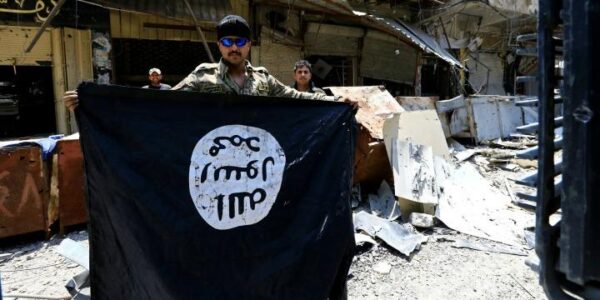
Islamic State resurrection is a cause for alarm
The February 3 killing of ISIS leader Abu Ibrahim al-Qurayshi in a US Special Forces raid comes amid concerns that the ruthless terrorist movement once considered defeated is reconstituting.
ISIS executed 2,705 acts of terrorism last year, leaving 8,147 people killed or wounded, the Meir Amit Intelligence and Terrorism Information Center reports. That’s consistent with ISIS activity in 2020.
Two weeks before this month’s raid, ISIS attacked Syria’s al-Hasakah Central Prison, home to more than 4,400 ISIS prisoners, triggering a deadly, daylong siege.
“ISIS was defeated only in direct confrontations, but it has never been eliminated in Syria,” Fouad Aliko, a member of the Yekiti Kurdistan Party in Syria, told the Syrian Observatory for Human Rights.
“ISIS has learned from its defeats in battles and changed its tactics, and depends on executing attacks in small groups, which is more akin to guerrilla tactics.”
Al-Qurayshi’s death comes nearly three years after ISIS’ leader, Abu Bakr Al Baghdadi, was killed in a US strike on his compound. ISIS reportedly chose Abu Hassan al-Hashimi to succeed al-Qurayshi.
The daring prison ISIS attack started with oil tanks detonating nearby to create a diversion and cause enough smoke to nullify a possible air force retaliation. ISIS fighters then attacked the prison from multiple fronts. Ten days of fighting resulted in the deaths of hundreds of people, and about 117 from the Syrian Democratic Forces (SDF) and prison guards.
SDF is a Kurdish fighting force allied with the United States. It accused Turkey of facilitating the prison attack by allowing ISIS a “safe zone” in northern Syria, where Turkey has a military presence.
Iraqi Security Cell, a media bureau for the Iraqi prime minister, said that about 3,900 prisoners were moved to a new prison, and 100 others were in a nearby hospital. The Iraqis, who fought tooth and nail against ISIS, remain wary of any presence of ISIS on its border with Syria.
Iraqi forces subsequently launched raids and airstrikes on ISIS hideouts.
SDF captured an ISIS financier on February 13, who was in charge of paying ISIS families and terrorists in northern Syria. He confessed to carrying money from Turkey to Adlib. Earlier this month, Spanish police arrested five suspects in four different cities who operated as ISIS financiers and recruiters in Libya.
ISIS terrorists reportedly committed unspeakable atrocities during the prison siege. Security guards’ hands and limbs were severed, and some people were thrown alive into a furnace, Syrian Observatory for Human Rights founder Rami Abdulrahman told Sky News Arabia.
ISIS reacted to al-Qurayshi’s death by launching attacks on civilian and governmental targets in Iraq, Afghanistan, and some of Africa, through its offshoots in Nigeria, Niger, Congo, and Mozambique.
The same week as the Syrian prison assault, the Islamic State of Central Africa Province (ISCAP) was able to spring 20 prisoners and kill three people while executing a strikingly similar attack on a Congo prison. “The soldiers of the Caliphate attacked a post of the Crusader Congolese army in the town of Nobili, near the Ugandan border, two days ago, causing its personnel to flee,” said an ISIS communique.
The ISIS branch in Congo killed an estimated 849 people in 2020, the United Nations Joint Human Rights Office reported.
ISIS launched hundreds of terrorist attacks in the Middle East and Europe between 2014 and 2019. Last month, Sweden and France launched a joint probe to investigate ISIS atrocities against the Yazidi minority in Iraq and Syria. It is believed that 10,000 Yazidis were killed and around 7,000 women were enslaved by ISIS during its reign of terror.
The death of a terrorist group’s leader can trigger power struggles and other setbacks. But ISIS is better able to move on with a new leader because it has “well-managed leadership structures and succession protocols,” wrote Haroro Ingram, Amira Jadoon, and Andrew Mines, in a recent piece.
“The death of al-Qurayshi is unlikely to affect the operations of Islamic State group’s affiliates in any meaningful way,” they concluded.
The recent coordinated ISIS attacks cannot be ignored. The previous iteration of the group, which caused havoc across the globe, started in the same manner in Iraq and Syria before it declared its state and Caliphate in Mosul in 2014.
A series of attacks on Iraqi prisons in 2012 and 2013 freed a large number of jihadists who later join the Islamic State. These attacks were masterminded by al-Baghdadi.
“We remind you of your top priority, which is to release the Muslim prisoners everywhere,” said al-Baghdadi.
As Iraqis begin to heal from the scourge of the ISIS and rebuild, news of the increase in ISIS attacks in Iraq and neighboring Syria is alarming.
The dangers of a possible resurgence remain high, and the group’s ability to coordinate terrorist strikes can inspire a lot of its followers in the West and others across the world.
Source: Algemeiner





